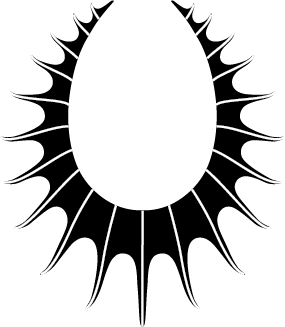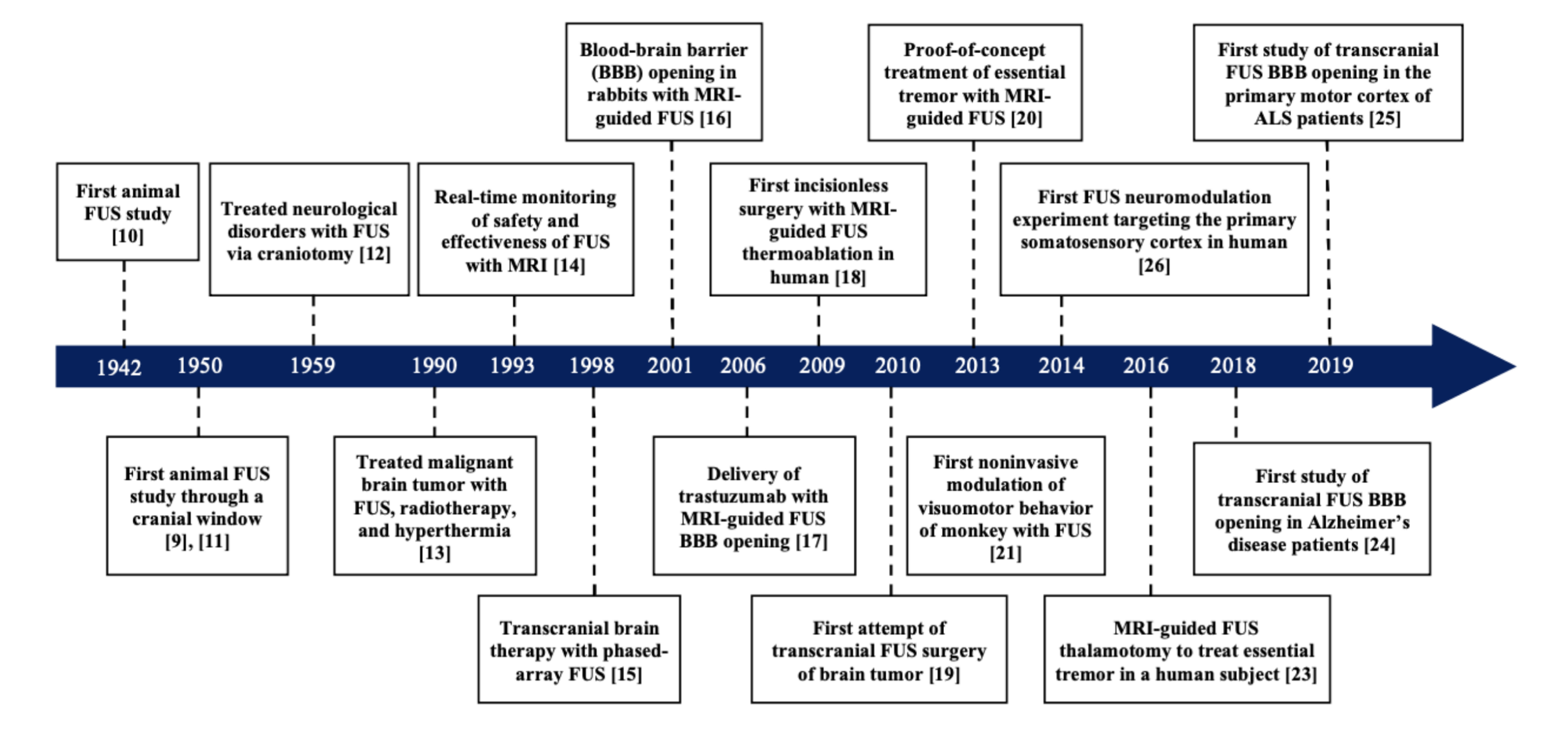Ultrasonic Transformers: Towards a Noetic Frontier
Overview
Over the last two decades, focused ultrasound has made tremendous strides beyond the preexisting neurotechnology, particularly in the realm of neuromodulation due to massive improvements in transcranial ultrasound technology, or tFUS. In this article we will expound on the technologies behind tFUS and the path it has taken to get to the state of the art, and— more importantly— project a data driven image in the future that follows a trend we call Wes’s Law. Additionally, the advent of neural transformers has unlocked the ability to decode neural data with incredible accuracy and then generate neural firing sequences with the same fidelity ChatGPT producers text.
Historical Milestones
While ultrasound has long been used for imaging and surgery, 2002 marked a paradigm shift towards neuromodulation, and in 2014, research findings illuminated that transcranial Focused Ultrasound (tFUS) held the capability to both stimulate and inhibit neural circuits in humans, ushering in a novel dimension to this field of study. The technology inherits a long line of research, ultrasound has been around for 80 years, but tFUS itself is very new. Foundational advancements have been made throughout the last century, enhancing ultrasound engineering all while ignoring its current most significant use case, transcranial stimulation. For example, 1983 saw the inception of beam angle steering using phased arrays, however it took 3 decades, until 2013 for FUS to be coupled with MRI while modulating neural activity in awake non-human primates. Just one year later, in 2014, FUS was used to target the primary somatosensory cortex in humans, significantly attenuating somatosensory evoked potentials.
Current Landscape
The underlying mechanisms behind neuromodulatory processes induced by transcranial focused ultrasound are multifaceted, and are still being researched at large. While current research explores specific material response to ultrasound, mechanical interactions are generally accepted to be playing the primary role in the stimulatory and inhibitory processes induced by tFUS.
This sets tFUS apart from other neurotechnologies by limiting secondary and collateral effects in contrast to other methods of neuromodulation. In addition to the mechanical fail-safe of US, tFUS emerges superior in terms of spatial precision. Its capability to focus intently on intricate regions of interest within the brain, deep or shallow without impacting superficial or surrounding tissues sets it apart.
Transducer Technology and Trends
The core hardware behind Transcranial FUS— and ultrasound in general— is a type of device called a transducer. Transducers are the central technology to ultrasound wave production and are used across the aforementioned ultrasound technologies. Transducers bidirectionally convert electrical and mechanical energies through uniquely capable materials.
There are multiple types of transducers. Piezoelectric materials (PZT)— notably Lead Zirconate Titanate, along with other crystal forms— have long been the cornerstone of medical ultrasound transducers; however technological advancements over the past decade have augmented existing transducers and created new types of transducers, all while favoring improvements to the breadth of frequency and the resolution and steerability of focal regions.
Here’s a brief overview of 4 commonly used types of transducers— PZT, CMUT, PMUT, and Optoacoustic:
Piezoelectric Transducers (PZT) - PZT is a thin piezoelectric layer sandwiched by conductive layers. While there are piezoelectric elements in PMUTs as well, they differ by sandwiched layers, and PZTs traditionally have less elements. PZT requires high frequencies and has high attenuation rates. This limits the range of the generated ultrasonic beam.
Capacitive micromachined ultrasonic transducers (CMUT) - CMUTs are composed of parallel plate capacitors which consists of one movable and one fixed electrode. In contrast to piezoelectric transducers, CMUTs have higher density arrays and broader frequency bandwidth. They operate on the principle of electrostatic actuation, generating ultrasound pressure from.
Piezoelectric Micromachined Transducers (PMUT) - PMUTs include a piezoelectric element and an insulator sandwiched by two electrodes that create an alternating currents field. While similar to CMUTs, PMUTs provide no high bias voltage, higher capacitance, and are easier to fabricate.
Optoacoustic arrays - Recently, optoacoustic transducers, which use lasers to induce ultrasonic waves, have produced micrometer (1-3 neuron) level precision, but are not currently capable of being assembled into arrays because of the large size of the transducer rig.
In addition to the evolution of means to convert electrical energy to mechanical energy, transducers have evolved in complexity. Different yield improvements in capability similar to those achieved by advancing transduction techniques.
One common form of transducer is the array. This is a transducer with multiple elements, a string of piezoelectric elements or other means of transduction. Arrays are extremely useful; they rely on constructive interference between the waves produced by individual elements. This significantly augments transducer capabilities in two ways, focusing and steering: Instead of beam projections, focused arrays create comparably small 3D focal areas, and rather than a physical pivot in the direction of the transducer, each element can be stimulated in succession causing steering along the dimension of the array.
As dimensionality increases, steerability increases. 1 dimensional arrays, strings, may steer along the axis of that array, but a 2D array, such as a square of piezoelectric elements, allows for both steering laterally and vertically. Finally 3D arrays, such as bowls, or annular arrays (concentrically embedded arrays) allow for steering along the z-axis. All together these capabilities allow for a small focal area within a much larger region of focal accessibility.
As transducers performance has improved over time, changes to certain design specs of improved transducers has been consistent. These trends follow key metrics, a pattern we like to call Wes’s Law: As transducer size decreases, as the amount of piezoelectric elements increases, and as the dimensionality of arrays increases, the focal volume decreases, allowing for more predictable and more precise stimulation.
Wes’s Law can be broken into 3 rules:
1. As transducer size decreases, the volume of the focal point decreases.
2. As elemental count increases in multielement array transducers, the volume of the focal point decreases.
3. As dimensionality increases in multi element array transducers, the volume of the focal point decreases.
Wes’s Law: As transducer size shrinks, as the amount of elements increases, and as the dimensionality of arrays increases, the focal volume decreases, allowing for more predictable and more precise stimulation.
Generative Ultrasonic Transformer
The transformer architecture, which is the technology underpinning powerful LLMs like ChatGPT, has established itself as the holy grail of sequential pattern recognition and generative artificial intelligence. Modified versions have been developed to process EEG neural activity and has established itself as the new state-of-the-art of neural decoding.[14] EEG Convolutional Transformer Encoder Architecture. [14]
This year we are partnering with the Donders Institute on a study to collect the largest dataset of fMRI imaging data of lucid dreamers. With this data, we are standardizing a dataset of neural activation patterns of lucid dreams and modifying a generative decoder block to output steering controls for the ultrasonic stimulation pulses. This will allow the system to artificially mimic the neural activity observed in naturally occurring lucid dreams.
Future Projections:
This trend leads us to conclude that transcranial Focused ultrasound will continue to see improvements along the parameters mentioned within Wes’s law. The forthcoming generation of tFUS is anticipated to be able to target micrometer level precision. While pinpoint focal volumes may be a couple decades off, focal volume will undeniably continue to decrease as research explores new forms of transducer mechanics and increased dimensionality. While Wes’s law bodes well for the future of ultrasound hardware, recent leaps in software may prove just as impactful to the use cases and performance of tFUS.
The role of AI cannot be understated. Transformers will be leveraged to optimize parameter settings, and ensure precise and efficient procedures. AI coupled with a feedback loop between EEG and tFUS will allow us to create monitored, precise, and continuously adjusting focal stimulation. With this technology Prophetic is pursuing predictable and reliable lucid dream induction and stabilization for the general consumer - but exploration of the entire state-space of conscious experience awaits.
Articles Referenced:
Fry, F. J., & Fry, W. J. (1958). "Ultrasonic irradiation of the white and gray brain matter: Anatomical and physiological effects". Proceedings of the Society for Experimental Biology and Medicine. PMC8870582.
Beale, S. B., & Sato, M. (2002). "A three-dimensional computational study of the effects of anisotropy on the propagation of shock waves in solids". Physics in Medicine & Biology, 47(8), 301-310. 10.1088/0031-9155/47/8/301.
Zhao, H., Zhang, Q., & Li, X. (2007). "High performance piezoelectric micro ultrasonic transducers". IEEE Transactions on Ultrasonics, Ferroelectrics, and Frequency Control, 54(8), 1609-1618. 4121676.
Zhang, H., & Wu, J. (2017). "Recent advances in broadband high-resolution photoacoustic microscopy: a review". Photoacoustics, 7, 14-29. PMC5635341.
Lee, W., & Kim, J. (2015). "Piezoelectric nanogenerators for self-powered nanodevices". PLOS ONE, 10(4), e0124237. PMC4431219.
Wang, X., & Liu, Y. (2022). "Development and application of piezoelectric materials for ultrasound generation and detection". Ultrasonics, 112, 106434. PMC9856188.






